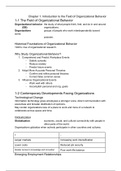Chapter 1: Introduction to the Field of Organizational Behavior
1-1 The Field of Organizational Behavior
Organizational behavior the study of what people think, feel, and do in and around
(OB) organizations.
Organizations groups of people who work interdependently toward
some
purpose.
Historical Foundations of Organizational Behavior
1940’s: rise of organizational research.
Why Study Organizational Behavior?
1. Comprehend and Predict Workplace Events
- Satisfy curiosity
- Reduce anxiety
- Predict future events
2. Adopt More Accurate Personal Theories
- Confirm and refine personal theories
- Correct false common sense
3. Influence Organizational Events
- Work well with others
- Accomplish personal and org. goals
1-2 Contemporary Developments Facing Organizations
Technological Change
Information technology gives employees a stronger voice, direct communication with
executives and broader distribution of opinions.
May render organizations less of a place to work and more of a network to
collaborate across space and time.
Globalization
Globalization economic, social, and cultural connectivity with people in
other parts of the world.
Organizations globalize when actively participate in other countries and cultures.
+ -
Larger markets Increasing work intensification
Lower costs Reduced job security
Greater access to knowledge and innovation Poor work-life balance
Emerging Employment Relationships
,Work-life balance the degree to which a person minimizes conflict between
work and nonwork demands.
Remote work performing most job duties at client sites.
Telecommuting an arrangement whereby, supported by information
(teleworking) technology, employees work from home one or more
work days per month rather than commute to the office.
+ -
Attractive for younger job applicants More social isolation
Lower turnover Less word-of-mouth information
Higher productivity Lower team cohesion
Reduces greenhouse gas emissions Weaker organization culture
Reduces office expenses
Increasing Workforce Diversity
Surface-level diversity the observable demographic or physiological differences
in people, such as their race, ethnicity, gender, age, and
physical disabilities.
America’s Multigenerational Workforce
Deep-level diversity differences in the psychological characteristics of
employees, including personalities, beliefs, values and
attitudes.
Consequences of Diversity
+ -
More creative Take longer to perform effectively
together
Better decisions in complex situations Increase risk of dysfunctional conflict,
which reduces information sharing and
satisfaction
Better able to recognize and address
community needs
1-3 Anchors of Organizational Behavior Knowledge
The Systematic Research Anchor
Evidence-based the practice of making decisions and taking actions based
, management on research evidence
Why not consistently apply evidence-based management?
- bombarded with ideas from sources, which makes it difficult to see which
ones are based on good evidence.
- OB research is necessarily generic.
- sources are rewarded for marketing their ideas, not to test if they actually
work.
- Systematic research anchor
Study organizations using systematic research methods
- Multidisciplinary anchor
Import knowledge from other disciplines, not just create its own knowledge
- Contingency anchor
Recognize that the effectiveness of an action may depend on the situation
- Multiple levels of analysis anchor
Understand OB events from three levels of analysis: individual, team, organization
1-4 Perspectives of Organizational Effectiveness
Organizational a broad concept represented by several perspectives,
effectiveness including the organization’s fit with the external
environment, internal subsystems configuration for high
performance, emphasis on organizational learning, and
ability to satisfy the needs of key stakeholders.
Open Systems Perspective
Open systems a perspective that holds that organizations depend on the
external environment for resources, affect that
environment through their output, and consist of internal
subsystems that transform inputs to outputs.
Organization-Environment Fit
- Adapt to the environment
dynamic capability: adaptiveness of a company
- Influence the environment
- Move to a more favorable environment
Effective Transformation Process
Indicators of effective internal subsystems:
- efficiency
- adaptability
- innovativeness
, Organizational Learning Perspective
Organizational learning a perspective that holds that organizational effectiveness
depends on the organization’s capacity to acquire, share,
use, and store valuable knowledge.
Intellectual capital a company’s stock of knowledge.
Intellectual capital exists in 3 forms:
1. Human capital
the stock of knowledge, skills, and abilities among employees that provide economic
value to the organization.
2. Structural capital
knowledge embedded in an organization’s systems and structures
3. Relationship capital
the value derived from an organization’s relationships with customers, suppliers, and
others.
Four Organizational Learning Processes
Learning orientation beliefs and norms that support the acquisition, sharing,
and use of knowledge as well as work conditions that
nurture these learning processes.
High-Performance Work Practices Perspective
High-performance work a perspective that holds that effective organizations
practices (HPWPs) incorporate several workplace practices that leverage the
potential of human capital.
Examples:
- employee involvement






